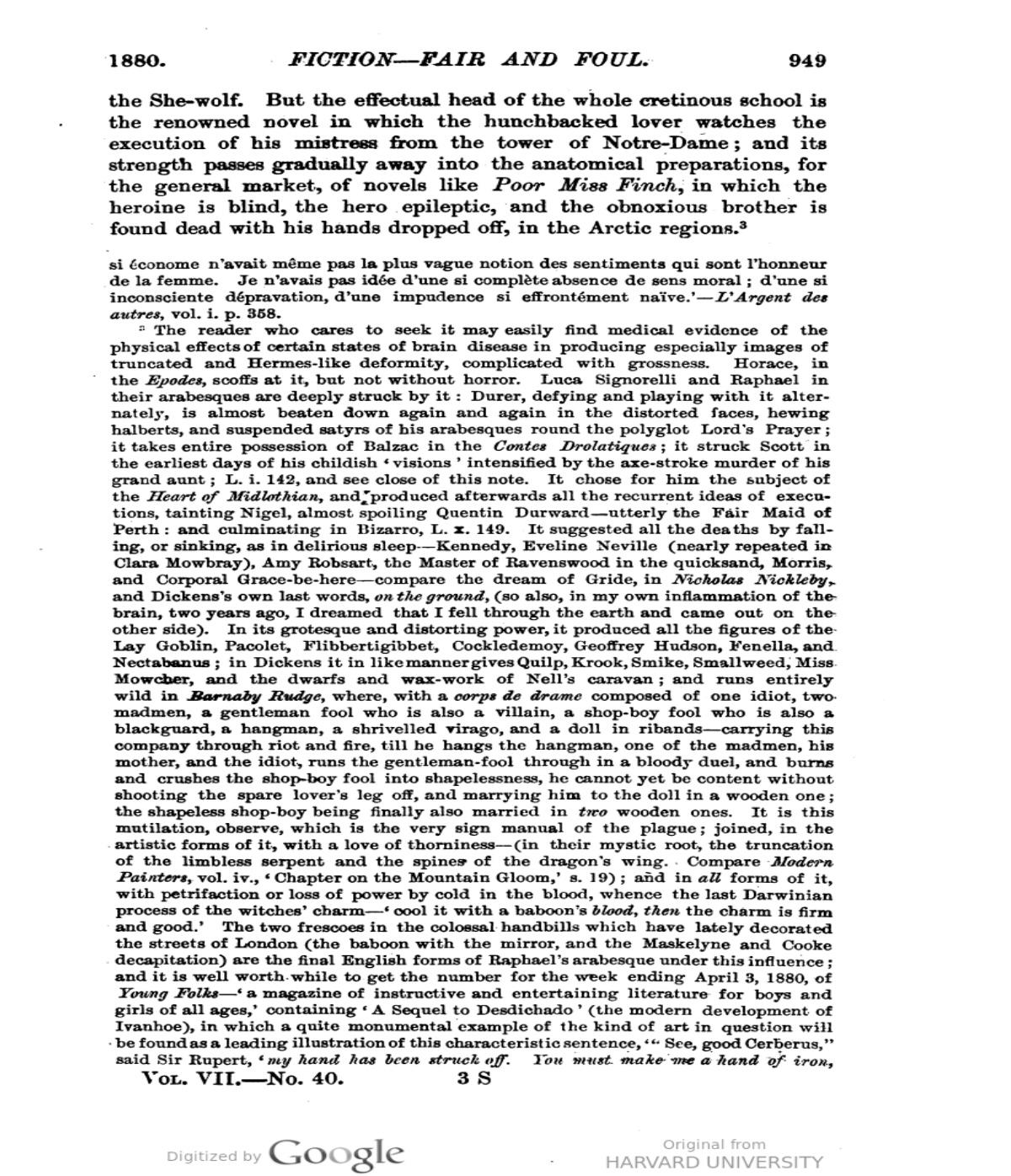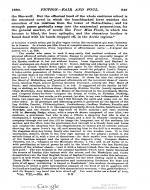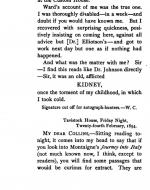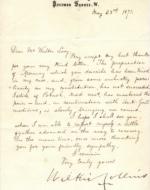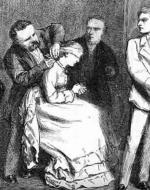Created by Anna Meredith on Mon, 04/26/2021 - 18:22
Description:
Introduction
Two distinguished Victorian authors that wrote about characters with disability during their time, Charles Dickens (1812-1870) and Wilkie Collins (1824-1889), both had a friendship and mentorship with each other. Dickens--known for his portrayal of disabled children in A Christmas Carol--and Collins-- known for his different, yet accurate portrayal of blindness in Poor Miss Finch-- were both suffering from illnesses and ailments of their own. In a Victorian society where views on disability were either unknown or unaccepted, Collins ignores critiques and instead depends on Dickens’s earlier influence and his own ailments as tools to guide his writings on disability. With Collins’s own illnesses, as well as Dickens’s mentorship, Collins is able to portray disability, specifically blindness, as it truly is in his novel Poor Miss Finch.
Ruskin, John. “Fiction - Fair and Foul.” HathiTrust, 23 Jan. 2021.
John Ruskin (1819-1900), a popular critic of the Victorian era, provides social commentary varying anywhere from gender duties to disability studies. In Ruskin’s book Fiction- Fair and Foul (1880), Ruskin says that Victorians have developed an increased fascination with the “analysis of physical corruption” (Ruskin 943). Meaning, Victorian readers are becoming more and more interested in disabled bodies. Ruskin, seemingly irritated by Victorian fiction’s focus on scenes of death and characters possessing illness and disability, believed that this fascination stemmed from the increased industrialization of the time. Ruskin continues his critique on disability in fiction by referring to authors who write on disability as members of a “cretinous school,” referring to the absurdity of Collins’s novel Poor Miss Finch in which “the heroine is blind, the hero epileptic, and the obnoxious brother is found dead with his hands dropped off” (Ruskin 949). While Ruskin critiques Poor Miss Finch as a novel, whether it was Ruskin’s attention or not, Ruskin also highlights the fact that the hero and heroine of the novel have disabilities, whereas the villain is able-bodied. Nonetheless, Ruskin goes even further in his critique by arguing that disabled characters are a result of the author’s brain disease.
Dickens, Charles. “Letters of Charles Dickens to Wilkie Collins : Charles Dickens , Wilkie Collins , Georgina Hogarth : Free Download, Borrow, and Streaming.” Internet Archive, Harper & Brothers, 1 Jan. 1891.
While Ruskin did not name Collins by name when describing disabled characters being the product of the author’s own brain disease, he did mention Collins’s novel Poor Miss Finch. However, it is unknown if Ruskin was aware of Collins’s and Dickens’s illnesses while they were writing and publishing Victorian disability fiction. Nonetheless, in 1853, Dickens and Collins were starting to correspond more through letters, after meeting two years prior. Dickens and Collins wrote letters back and forth, bonding over their mutual suffering from the onset of illness. In this letter to Collins, Dickens details the recurrence of his kidney problems that he had as a child, while also empathizing with Collins’s new health problems, which was probably the first sign of Collins’s rheumatoid gout and the pain that was to follow over the years. While Dickens was believed to burn the letters he received in his fireplace, including Collins’s letters, readers can still acknowledge, from this one sided correspondence, that Dickens and Collins became each other’s confidants as they suffered through illness.
At the time of this letter Dickens had published and gained success from the literary works of A Christmas Carol (1843) and The Cricket on the Hearth (1845), both containing characters with disabilities. Interestingly, in The Cricket on the Hearth, Bertha Plummer, a blind girl from birth, does not have any romantic attachments and Dickens keeps her far away from the marriage plot. Dickens was probably writing only what was accepted by Victorian society, as Victorians believed blindness was hereditary, therefore blind people were not to marry. In Collins’s own novel Poor Miss Finch (1872), Collins ignores society’s judgment on disability, and allows for his blind character Lucilla to be right in the middle of the marriage plot with two eligible suitors. With Collins’s respect for Dickens’s earlier works and Collins’s respect for Dickens’s portrayal of disability, Collins is able to write Poor Miss Finch unphased by society’s negative view on blindness.
Collins, William, and William Baker. The Public Face of Wilkie Collins: the Collected Letters. Vol. 2, Pickering & Chatto, 2005.
While Collins’s letters to Dickens will probably go undiscovered forever, Collins did write to others regarding his own health struggles. In a letter written in May of 1871, Collins writes to a Mr. Walter Lacy, who was probably studying medicine at the time, as he is not addressed as Doctor. Collins details both his successes and failures with different medications he was taking to relieve the painful gout he was experiencing. While the contents of the letter itself provide insight into Collins’s health, it is the fact that the letter is only signed by Collins, while the letter is transcribed by his housekeeper that is the most telling. The assumption can be made that while Collins was in bad health as a result of his gout, the gout may have also been affecting his eyesight, leading Collins to need to dictate his letters to his housekeeper at this time. The date of the letter is also significant as the year is 1871, and just a year later, Collins publishes Poor Miss Finch, a novel whose purpose was to portray blindness as it really is, including the pain that comes with regaining sight.
Bentley 1873 (with additional 'note to this edition'); Chatto & Windus 1875-1913 (with 12 illustrations, by G. du Maurier and E. Hughes); Sutton, Stroud 1994; World's Classics 1995 (critical edition, edited by C. Peters)
At the same time Collins was struggling with his gout, he was also writing Poor Miss Finch, a novel about a young blind woman who gains her sight back temporarily. Although Collins’s main focus was to portray blindness as it really is, gout does come up in the novel in the character of Grosse, the German oculist experimenting on Lucilla’s eyes: “he illustrated the position so forcibly with his own head that he shook his gouty foot, and screamed with the pain of it” (Collins Chapter 48). While Collins does mention small instances of Grosse’s illness in the novel, Collins primarily focuses on blindness. Not only that, but Collins is able to portray blindness the way it truly is, which comes with discomfort and possible pain:
Like all other people, knowing no more of the subject than I knew, I had no idea of the pitiably helpless manner in which the restored sense of sight struggles to assert itself, in persons who have been blind for life. In such cases, the effort of the eyes that are first learning to see, is like the effort of the limbs when a child is first learning to walk. But for Grosse's odd way of taking it, the scene which I was now to witness would have been painful in the last degree. (Collins Chapter 39)
The illustration picture is from an earlier edition of Poor Miss Finch, showing Lucilla about to have her bandages removed, gripping herself for the pain that is to come. In the preface of Poor Miss Finch Collins writes: “more than one charming blind girl, in fictions and in the drama, has preceded ‘Poor Miss Finch’” yet Collins aims to “appeal to an interest of another kind, by exhibiting blindness as it really is” (Collins). With Collins’s own disability, as well as the influence of Dickens, Collins is able to write disability in the way he has seen and experienced, regardless of social critique and commentary.

